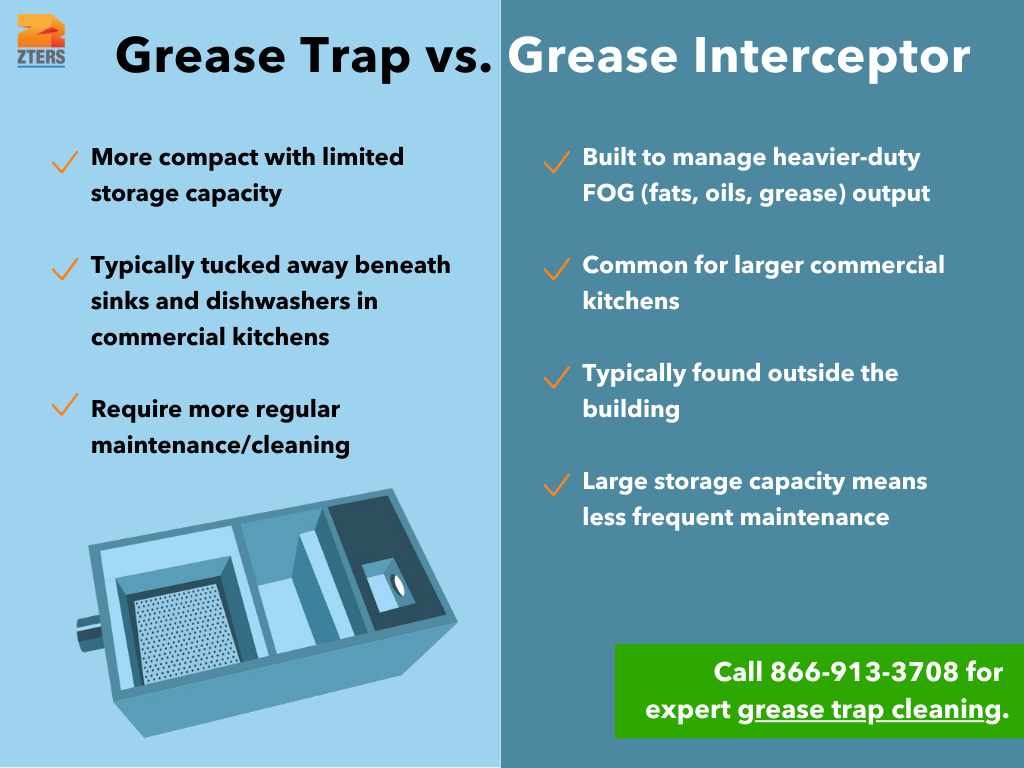Commercial kitchens are often fast-paced environments, leaving little time to worry about if fats, oil, and grease are being effectively managed. For this reason and many more, grease traps (and grease trap cleaning for that matter) are a critical part of any successful establishment.
Grease traps have been around for well over a century and their build has remained relatively unchanged since then. Hey, if it’s not broken, don’t fix it.
There’s another unit, however, that has commercial kitchen managers wondering if they’re using the best possible grease trapping option: the grease interceptor.
Both grease traps and grease interceptors keep fats, oil, and grease (FOG) from entering the sewage system, but how are they different? Here’s a refresher on what grease traps and grease interceptors are, how they differ, and why they’re essential.
What is a grease trap?
Grease traps are compact devices typically tucked away beneath sinks and dishwashers in commercial kitchens. These contraptions are designed to capture fats, oils, and grease before they wreak havoc in your plumbing. Here’s how grease traps work:
- Inlet: The wastewater from sinks and dishwashers flows directly into the grease trap.
- Separation: Within the trap, the wastewater undergoes a crucial transformation as it cools down, causing FOG to separate and float to the surface.
- Collection: The separated grease accumulates at the top of the trap, while cleaner water exits through an outlet.
- Maintenance: Grease traps require regular TLC in the form of grease removal to maintain efficiency and prevent pesky clogs.
For a more in-depth look at grease traps and cleaning services, check out our grease trap cleaning 101 post.
Need Grease Trap Cleaning?
Speak with an account manager for a free quote.
What is a grease interceptor?
Grease interceptors are built to manage heavier-duty FOG output. They’re common for larger commercial kitchens and are typically found outside the building. Here’s how grease interceptors work:
- Inlet: Wastewater from various kitchen sources enters the grease interceptor.
- Settling: Inside the grease interceptor, the water slows down, allowing solids to settle at the bottom.
- Separation: FOG, being lighter, rises to the top of the interceptor, creating a distinct layer.
- Retention: The separated FOG and solids are retained within the interceptor, while the comparatively cleaner water is discharged into the sewer system.
- Maintenance: Grease interceptors are equipped with larger storage capacities, which means they require less frequent maintenance than their smaller counterparts.
The main draw of grease interceptors is their ability to efficiently handle substantial volumes of FOG. They’re often mandated by local regulations for larger-scale food establishments such as hotels, industrial kitchens, and cafeterias.
Key Differences
Now that you’re more familiar with how each of these units work, let’s look at them side by side.
The most notable difference between grease traps and grease interceptors is size and capacity. Grease traps are compact and well-suited for smaller kitchens whereas grease interceptors are bulkier and built to handle much larger FOG volumes.

A second difference is the location of these two units. Grease traps reside inside kitchens whereas grease interceptors are typically located outside/next to the building.
Frequency of maintenance is another key difference. Grease trap cleaning service should happen on a regular basis to align with grease trap requirements. Grease interceptors require less-frequent attention, but should still be evaluated every so often.
Finally, there are different mandates related to grease traps vs. grease interceptors. Check with your local municipality to determine the specific requirements in your area. Avoid hefty fines and keep people safe.
Schedule a Grease Trap Cleaning Service with ZTERS
Choosing ZTERS for your grease trap cleaning service means choosing efficiency, compliance, and reliability. Our experienced team is here to help your commercial kitchen operate seamlessly while adhering to the highest environmental standards. Give us a call at 866-976-0262 to schedule your grease trap cleaning today!
Infographic: Grease Trap vs. Grease Interceptor


